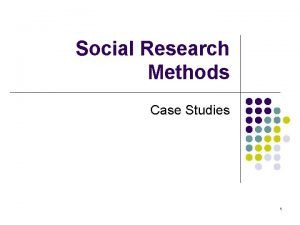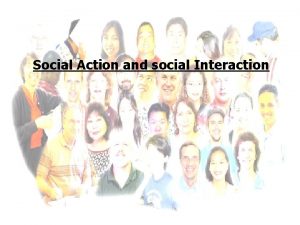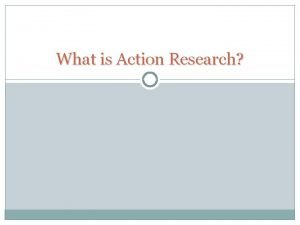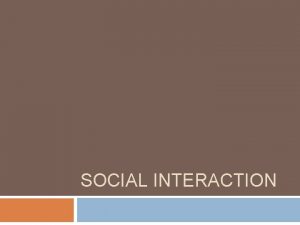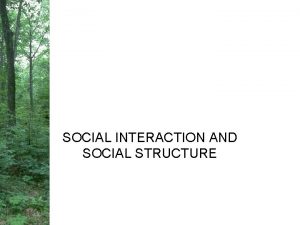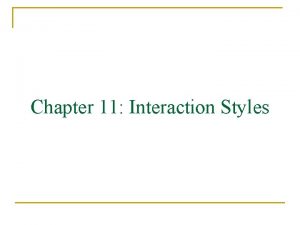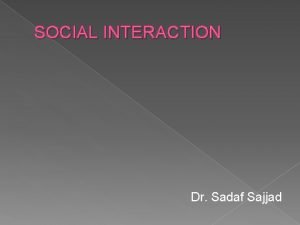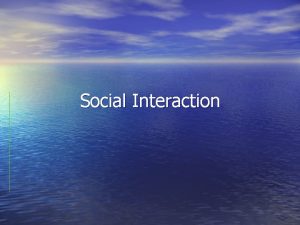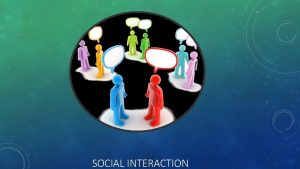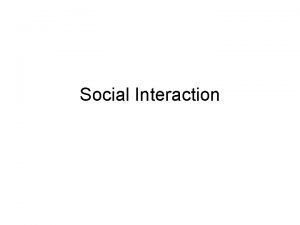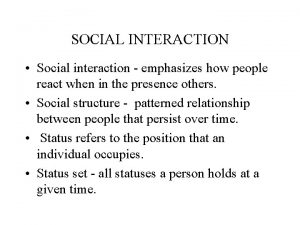Social Interaction Chapter 21 Social Interaction Case Study




























- Slides: 28

Social Interaction Chapter 21: Social Interaction Case Study: Acts of Altruism Section 1: Group Behavior Section 2: Conformity and Obedience Section 3: Aggression and Altruism Experiment: Applying What You’ve Learned Original Content Copyright by HOLT Mc. Dougal. Additions and changes to the original content are the responsibility of the instructor.

Social Interaction Section 1 at a Glance Group Behavior • People behave differently in groups than they do as individuals. • Being a member of a group does not always improve individual performance. • Many important decisions are made by groups rather than by individuals. • People tend to take greater risks as part of a group than they would if they were acting alone. Original Content Copyright by HOLT Mc. Dougal. Additions and changes to the original content are the responsibility of the instructor.

Social Interaction Group Behavior Main Idea People behave differently in groups than they do as individuals. Often, they are willing to take greater risks in a group. Reading Focus • What is social facilitation? • How would you define social loafing and risky shift? • What are some characteristics of group decision-making? • What is group polarization? • How would you describe group leadership? Original Content Copyright by HOLT Mc. Dougal. Additions and changes to the original content are the responsibility of the instructor.

Social Interaction Social Facilitation • People may try harder, take greater risks, or make different decisions when they are with others than they would if they were alone. Why is this so? • People often perform better when other people are watching. The presence of other people seems to facilitate and encourage one’s performance. This phenomenon is called social facilitation. • Evaluation apprehension, or the concern about the opinion of others, is another reason the presence of other people may improve performance. Original Content Copyright by HOLT Mc. Dougal. Additions and changes to the original content are the responsibility of the instructor.

Social Interaction Reading Check Summarize Who or what does social facilitation affect? Answer: performance Original Content Copyright by HOLT Mc. Dougal. Additions and changes to the original content are the responsibility of the instructor.

Social Interaction Social Loafing and Risky Shift • Being a member of a group does not always improve performance. When people are working toward a common goal, they may “slack off” and not try as hard. This behavior is called social loafing. • Social loafing may occur because of diffusion of responsibility— the tendency of people to feel less responsible for accomplishing a task when the effort is shared among other members of a group. • A related phenomenon is the risky shift—the tendency for people to take greater risks when they are part of a group than they would as individuals acting on their own. • People may feel more powerful or less vulnerable as part of a group. • The risky shift may help explain such events as prison riots and mob attacks. Original Content Copyright by HOLT Mc. Dougal. Additions and changes to the original content are the responsibility of the instructor.

Social Interaction Reading Check Find the Main Idea What is diffusion of responsibility? Answer: the tendency for people to feel less responsible for accomplishing a task when the effort is shared among members of a group Original Content Copyright by HOLT Mc. Dougal. Additions and changes to the original content are the responsibility of the instructor.

Social Interaction Group Decision-Making Many important decisions are made by groups rather than by individuals. Psychologists have identified a number of social decision schemes, or rules that govern group decision-making. Majority-Wins Scheme Truth-Wins Scheme • In the majority-wins scheme, the group agrees to a decision that was initially supported by a majority of group members. • Often, the members of a group come to realize that one option is better than others after they learn more about the choices available. • The majority-wins scheme applies most often to situations in which there is no right or wrong choice. • This is called the truth-wins scheme. Original Content Copyright by HOLT Mc. Dougal. Additions and changes to the original content are the responsibility of the instructor.

Social Interaction Two-Thirds-Majority Scheme First-Shift Scheme • Some groups concur with a decision after two-thirds of their members come to an agreement about the correct choice. • The first-shift scheme applies to groups that are deadlocked about a decision. • This is the two-thirds majority scheme. • If one person shifts from one side to the other, others may shift to the opposite side as well. • It often applies to jury decisions. Original Content Copyright by HOLT Mc. Dougal. Additions and changes to the original content are the responsibility of the instructor.

Social Interaction Reading Check Summarize Which scheme applies to groups that are deadlocked? Answer: first-shift scheme Original Content Copyright by HOLT Mc. Dougal. Additions and changes to the original content are the responsibility of the instructor.

Social Interaction Group Leadership • All groups have leaders who serve several important functions in their groups. – Identify goals – Establish and implement plans – Emotional support • Some leaders are appointed by outsiders; others are chosen by a vote of group members. • Informal groups may not have official leaders, though some members are likely to have more influence than others. • Group leaders often have certain personality traits or skills. Many are self-confident, outgoing, and intelligent. • Leaders differ in how they operate. Original Content Copyright by HOLT Mc. Dougal. Additions and changes to the original content are the responsibility of the instructor.

Social Interaction Authoritarian Leaders Democratic Leaders • Authoritarian leaders exert absolute control over all decisions for the group. • Democratic leaders encourage group members to express and discuss their ideas and, in addition, to make their own decisions. • Military leaders are authoritarian leaders to those below them. Laissez-Faire Leaders • Laissez-faire leaders encourage group members to express and explore their own ideas. • These leaders have a less active role in the decision-making process. Comparing Leadership Styles • No one style of leadership is best for every group. • Different situations call for different styles of leadership. Original Content Copyright by HOLT Mc. Dougal. Additions and changes to the original content are the responsibility of the instructor.

Social Interaction Reading Check Analyze What is an authoritarian leader? Answer: a group leader who exerts absolute control over all decisions for the group Original Content Copyright by HOLT Mc. Dougal. Additions and changes to the original content are the responsibility of the instructor.

Social Interaction Section 2 at a Glance Conformity and Obedience • People who conform bring their behavior into line with that of a group. • Solomon Asch investigated the extent to which people conform to social norms. • One of the most obvious influences on people’s behavior is the power of people in authority to compel them to obey. Original Content Copyright by HOLT Mc. Dougal. Additions and changes to the original content are the responsibility of the instructor.

Social Interaction Conformity and Obedience Main Idea The pressure to conform is an indirect social influence on behavior. The power of people in positions of authority is a more direct social influence. Reading Focus • Why are groups and social norms important? • What were Asch’s studies of conformity? • Why do people conform? • What was the purpose of Milgram’s studies of obedience? • Why do people obey? Original Content Copyright by HOLT Mc. Dougal. Additions and changes to the original content are the responsibility of the instructor.

Social Interaction Importance of Groups and Social Norms • How people behave toward each other depends upon a variety of factors. • The least direct social influence on behavior is the pressure to conform. People who conform bring their behavior in line with that of a group. • Being accepted by a group can be important because groups help people satisfy many needs, such as belonging, affection, attention, and support during difficult times. Groups also may help people accomplish things they could not accomplish on their own. • Belonging to a group usually means conforming to the group’s social norms. Social norms are standards of behavior that people share. • Social norms can be explicit or implicit. Explicit norms are spoken or written rules. Implicit norms are unspoken, unwritten rules. • Social norms can be useful or harmful. Original Content Copyright by HOLT Mc. Dougal. Additions and changes to the original content are the responsibility of the instructor.

Social Interaction Reading Check Find the Main Idea What are implicit norms? Answer: unspoken, unwritten rules Original Content Copyright by HOLT Mc. Dougal. Additions and changes to the original content are the responsibility of the instructor.

Social Interaction Section 3 at a Glance Aggression and Altruism • Aggression, words or actions that are intended to harm other people, is a widespread social problem. • Freud believed that aggressive urges are unavoidable reactions to the frustrations of daily life. • Cognitive psychologists maintain that aggressive behavior is influenced by people’s values. • An unselfish concern for the welfare of other people is the hallmark of altruistic behavior. Original Content Copyright by HOLT Mc. Dougal. Additions and changes to the original content are the responsibility of the instructor.

Social Interaction Aggression and Altruism Main Idea Aggression refers to words or actions that can hurt people. Altruism refers to words or actions that can help people. Reading Focus • How does biology influence aggression? • What are some features of the psychoanalytic and cognitive views of aggression? • How do learning and sociocultural theorists think about aggression? • What is altruism? • What factors affect altruism? Original Content Copyright by HOLT Mc. Dougal. Additions and changes to the original content are the responsibility of the instructor.

Social Interaction Biological View of Aggression refers to words or actions that are meant to hurt other people. It is a serious and widespread social problem. Why are people aggressive? The brain and hormones appear to be involved. • In response to certain stimuli, many lower animals react with instinctive aggression. • The male sex hormone testosterone is involved in aggression. • Electrical stimulation of the hypothalamus appears to trigger this aggressive behavior in animals. • Higher levels of testosterone result in higher levels of aggression. • Humans are more complex. • Aggression can contribute to survival, but now, intelligence and organizational skills also matter. Original Content Copyright by HOLT Mc. Dougal. Additions and changes to the original content are the responsibility of the instructor.

Social Interaction Reading Check Identify What is the male sex hormone involved in aggression? Answer: testosterone Original Content Copyright by HOLT Mc. Dougal. Additions and changes to the original content are the responsibility of the instructor.

Social Interaction Psychoanalytic and Cognitive Views Psychoanalysis and Aggression Cognitive Psychology and Aggression • Freud and the psychoanalytic view see aggression as normal but typically repressed. • Cognitive psychologists maintain that aggression is influenced by people’s values, perceptions, and choices. • Freud believed repressed aggression was likely to find other outlets. • Less harmful forms of aggression were to be encouraged to vent the pressure of repressed aggression. • Psychologists refer to such venting of aggressive impulses as catharsis. • People act aggressively because they believe aggression is justified, either in general or in particular situations. • Frustration and suffering may trigger feelings of anger and these feelings may cause people to act aggressively. Original Content Copyright by HOLT Mc. Dougal. Additions and changes to the original content are the responsibility of the instructor.

Social Interaction Reading Check Summarize What is catharsis? Answer: a less harmful expression of aggression, such as cheering on a sports team Original Content Copyright by HOLT Mc. Dougal. Additions and changes to the original content are the responsibility of the instructor.

Social Interaction Learning and Sociocultural Views Learning Theorists Sociocultural Theorists • Learning theorists believe that people learn to repeat behaviors that are reinforced. • Sociocultural theorists argue some cultures encourage independence and competitiveness and that this promotes aggression. • Aggression may be reinforced because it helps people get their own way. • In sports, aggression helps players win games and winning earns players admiration and money. • Observation also plays a role. People observe aggression on TV, in movies, and in video games. • The U. S. is a good example. Most Americans place a high value on individual rights and freedoms and emphasize competition. • When a person is strongly encouraged to win over others, hostility and aggression may result. • Other cultures place greater value on the group. Original Content Copyright by HOLT Mc. Dougal. Additions and changes to the original content are the responsibility of the instructor.

Social Interaction Reading Check Contrast What are examples of competitive and cooperative societies? Answer: The United States is an example of a competitive society; Japan and Korea are examples of cooperative societies. Original Content Copyright by HOLT Mc. Dougal. Additions and changes to the original content are the responsibility of the instructor.

Social Interaction Altruism and Others • Altruism is an unselfish concern for the welfare of other people. • Evolutionary psychologists believe that altruism, like aggression, is linked to genetics. • By helping their relatives survive and reproduce, early humans indirectly pass their genes on the next generation. In this way, genes for altruism have come to be a part of the human gene pool. • The evolutionary explanation of altruism has been criticized because no clear-cut genetic basis for altruistic behavior has been found, and the tendency to act altruistically varies too widely under genetic control. • The evolutionary view has also been criticized for not explaining why people act altruistically toward those to whom they are not related. Original Content Copyright by HOLT Mc. Dougal. Additions and changes to the original content are the responsibility of the instructor.

Social Interaction Factors Promoting and Inhibiting Altruism • Several factors influence whether a person will help others. • One factor is a person’s state of mind. People are more likely to help others when they are in a good mood. • People who have problems themselves and people who are empathic may be more likely to act altruistically. • Being competent to help others seems to make a person more likely to act altruistically. • People with a strong need for approval also may be more likely to act altruistically. • A sense of personal responsibility may increase the chances of altruistic behavior. Original Content Copyright by HOLT Mc. Dougal. Additions and changes to the original content are the responsibility of the instructor.

Social Interaction Inhibiting Factors • Several factors seem to make people reluctant to help others. • A person may be unaware that someone needs his or help. • A person may think there is nothing he or she can do. • A person may fear social blunder, ridicule, or personal injury. Bystander Effect • The chances of altruism depend on how many other people are present to help. • People are less likely to give aid when other bystanders are present. This is the bystander effect. • Psychologists John Darley and Bibb Latané demonstrated the bystander effect with their classic experiment. Original Content Copyright by HOLT Mc. Dougal. Additions and changes to the original content are the responsibility of the instructor.
 Best case worst case average case
Best case worst case average case Project failure case study
Project failure case study Sam and verna
Sam and verna Case study in social research
Case study in social research Professional issues in information system
Professional issues in information system Social action vs social interaction
Social action vs social interaction Industrialization case study manchester
Industrialization case study manchester Chapter 12 case study
Chapter 12 case study Case study of unix operating system
Case study of unix operating system Case study chapter 4
Case study chapter 4 Use case model
Use case model Long case and short case
Long case and short case Average case for binary search
Average case for binary search Glennan building cwru
Glennan building cwru Bubble sort best case and worst case
Bubble sort best case and worst case Bubble sort best case and worst case
Bubble sort best case and worst case Bubble sort best case and worst case
Bubble sort best case and worst case Sas ambiguous case
Sas ambiguous case Zara technology case study
Zara technology case study Yelp case study analysis
Yelp case study analysis Case of kf
Case of kf Swot analysis of whole foods
Swot analysis of whole foods Action research vs case study
Action research vs case study Volkswagen case study ppt
Volkswagen case study ppt Valuation of plant machinery and equipment
Valuation of plant machinery and equipment Phil stephens villanova
Phil stephens villanova Starbucks foreign direct investment
Starbucks foreign direct investment Case study questions for students
Case study questions for students Notasi uml
Notasi uml



